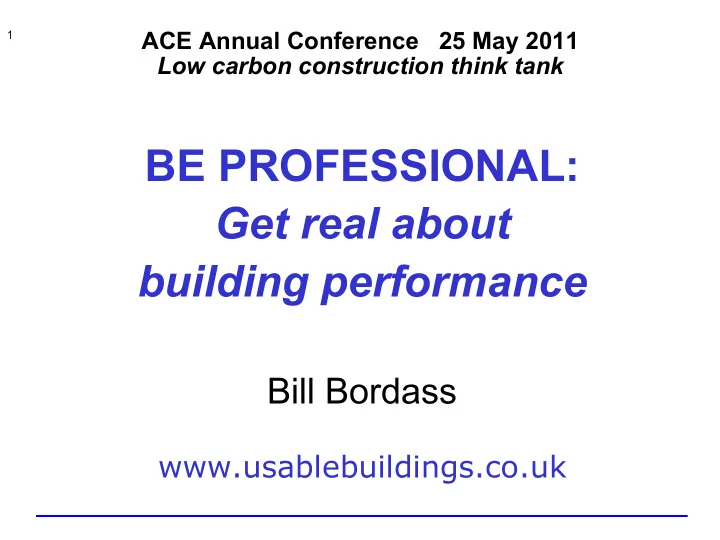

1 ACE Annual Conference 25 May 2011 Low carbon construction think tank BE PROFESSIONAL: Get real about building performance Bill Bordass www.usablebuildings.co.uk
2 For most designers and builders, building performance in use is another country … “ in theory, theory and practice are the same, in practice they aren ’ t. ” SANTA FE INSTITUTE for research into complex systems “ designers seldom get feedback, and only notice problems when asked to investigate a failure. ” ALASTAIR BLYTH CRISP Commission 00/02, UK “ I’ve seen many low-carbon designs, hardly any low-carbon buildings. ” ANDY SHEPPARD Arup, 2009 SOURCE: W Bordass, Flying Blind, Association for the Conservation of Energy & OXEAS (2001)
3 The Credibility Gap: We couldn ’ t deliver low-energy and carbon performance reliably in the 1990s. We ’ re still finding it difficult. Data from the winner of a Green Building of the Year Award << What the designers predicted << “Good” benchmark << Actual outcome SOURCE: see discussion in S Curwell et al, Green Building Challenge in the UK, Building Research+Information 27 (4/5) 286 (1999).
4 Recently-completed buildings: What do we tend to find? • Often they perform much less well than anticipated, especially for energy and carbon, often for occupants, and with high running costs. • Unmanageable complication is the enemy of good performance. So why are we being forced to make buildings more complicated in the name of sustainability, when we don’t get simple things right? • Buildings are seldom tuned-up properly and controls are poor. So if we have more to do, what chance do we have? • Design intent is seldom communicated well to users and managers, implicitly or explicitly. Designers and builders tend to go away at handover. • Good environmental performance and occupant satisfaction can go hand in hand, but only where committed people have made it happen. • Modern procurement systems make it difficult to pay attention to critical detail. Not a good idea when promoting innovation. • Facilities management services leave a lot to be desired. • Hardly fit-for-purpose for a low-carbon built environment!
5 Why are these lights on in a new university building?
6 Controls, manageability and usability need to receive much more attention ! ? “ An intelligent building is one that doesn ’ t make its occupants feel stupid ” … ADRIAN LEAMAN “ We sell dreams and install nightmares ” … BMS SUPPLIER
7 Why are we being encouraged to spend money on green bling when we aren ’ t getting the fundamentals right?
8 Changing the way we do things: A new professionalism? • Construction-related institutions require their members to understand and practice sustainable development. • How can members do this unless they understand the consequences of their actions? SO WE NEED TO: • Re-define perceptions of the building professional’s role, to engage with outcomes. • Get to places that markets cannot reach. • Close the feedback loop – rapidly. • Make much more immediate and effective links between research, practice and policymaking.
9 New professionals follow design intent through into reality • They understand what is needed strategic briefing • Are clear what they want, and communicate it plainly strategic design • Are ambitious, but realistic question all assumptions, understand users • Follow things right through e.g. using Soft Landings procedures • Review what they do manage expectations, undertake reality checks • Make others aware of what they are after specify: what, why and how • Check that things will work technical feasibility, usability and manageability • Get things done well, with attention to detail communicate, train, inspect • Finish them off commission, operational readiness, handover, dialogue • Help users to understand and take ownership provide aftercare support • Review performance in use including post-occupancy evaluation • Work with occupiers to make things better monitoring, review and fine tuning • Anticipate and spot unintended consequences revenge effects • Learn from it all and share their experiences TRY TO MAKE THINGS SIMPLER AND DO THEM BETTER … only making them complicated where this is essential.
10 Soft Landings: Helping to enable the new professionalism 1. Inception and Briefing Appropriate processes. Assigned responsibilities. Well-informed targets. 2. Design and construction Including expectations management. 3. Preparation for handover better operational readiness. 4. Initial aftercare Information, troubleshooting, liaison, fine tuning, training. 5. Longer-term aftercare monitoring, review, independent POE, feedback and feedforward. Runs alongside any construction process Downloadable free from www.usablebuildings.co.uk and www.softlandings.org.uk BSRIA is hosting an industry group SOURCE: downloadable from www.usablebuildings.co.uk and www.softlandings.org.uk
11 www.usablebuildings.co.uk
Recommend
More recommend